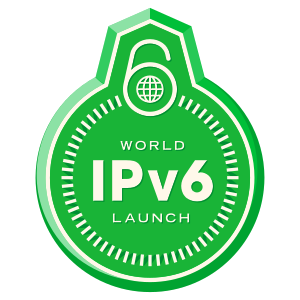World IPv6 Day and World IPv6 Launch Day facts for kids
Imagine the internet as a huge city with many houses. Each house needs an address so mail can be delivered. On the internet, these addresses are called IP addresses. For a long time, most of the internet used a system called IPv4 (Internet Protocol version 4) for these addresses. But just like a city can run out of house numbers, the internet was running out of IPv4 addresses!
To solve this, a new system called IPv6 was created. It has many, many more addresses. To help everyone switch to this new system, the Internet Society and big internet companies like Google and Facebook held two special events: World IPv6 Day in 2011 and World IPv6 Launch in 2012. These events were like big tests and then a permanent switch to help the internet move to IPv6.
Contents
What Was World IPv6 Day?
World IPv6 Day was a big test that happened on June 8, 2011. It was organized by the Internet Society to see how well the internet could handle the new IPv6 addresses. Big companies like Facebook, Google, and Yahoo joined in.
For 24 hours, these major websites turned on IPv6 for their main pages. This allowed computers that were ready for IPv6 to connect using the new system. The main goal was to find any problems or "brokenness" that might happen when people started using IPv6 more. It was also meant to encourage internet providers, hardware makers, and website owners to get ready for the big change.
Who Joined the Test?
More than 400 companies and organizations took part in World IPv6 Day. This included some of the most popular websites and internet services. Some famous participants were:
What Happened During the Test?
During World IPv6 Day, experts watched to see how much internet traffic used IPv6. They saw a small but important increase in IPv6 traffic. Most of this new traffic went to Google's websites, showing how important it was for big content sites to use IPv6.
The good news was that the day went pretty smoothly! Companies like Cisco and Google reported no major issues. Facebook was so happy with the results that they decided to keep IPv6 turned on for their developer website. Even though it was a success, everyone agreed that more work was needed to make IPv6 work perfectly everywhere. Many companies decided to keep their websites ready for both IPv4 and IPv6 at the same time.
What Was World IPv6 Launch?
Because World IPv6 Day went so well, the Internet Society decided to do something even bigger. On June 6, 2012, they held World IPv6 Launch. This time, it wasn't just a test. The plan was for all participating websites to turn on IPv6 permanently! They called it "this time, it's for real."
Who Joined the Launch?
Many of the companies that participated in the test day also joined the launch. Even more organizations joined too. One very important participant was the Wikimedia Foundation, which runs Wikipedia. They permanently turned on IPv6 for all their websites, including Wikipedia!
What Were the Results of the Launch?
The World IPv6 Launch was a big step forward. After the launch, a large part of the internet's content became available using IPv6. For example, at the Amsterdam Internet Exchange (a major internet hub), IPv6 traffic jumped by 50% on the launch day! This showed that more and more people and websites were starting to use the new internet address system.
See also
 In Spanish: Día Mundial de IPv6 y Lanzamiento Mundial de IPv6 para niños
In Spanish: Día Mundial de IPv6 y Lanzamiento Mundial de IPv6 para niños
- IPv6 deployment
- IPv6 brokenness and DNS whitelisting


